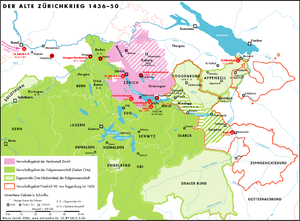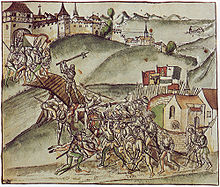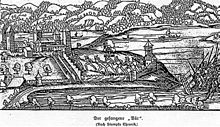- Old Zürich War
-
Old Zürich War / Alter Zürichkrieg 
Eastern Switzerland in the mid-15th century:
Territories of the Sieben Orte of the Swiss ConfederacyAssociates of the Swiss Confederacy Lands of Frederick VII, Count of Toggenburg, as of 1436 Modern Swiss border
Date 2 November 1440 – 12 June 1446 Location  Old Swiss Confederacy
Old Swiss ConfederacyResult Zürich roundly defeated; settled by the Peace of Einsiedeln, 13 July 1450 Territorial
changesSouthern Zürich littoral (March and Höfe) lost to Schwyz; Kyburg lost to the Habsburgs (until 1452) Belligerents  Imperial City of Zürich
Imperial City of Zürich
 Habsburg Further Austria
Habsburg Further Austria
 France
France Old Swiss Confederacy:
Old Swiss Confederacy:
 Canton of Bern
Canton of Bern Canton of Lucerne
Canton of Lucerne Canton of Uri
Canton of Uri Canton of Schwyz
Canton of Schwyz Canton of Unterwalden
Canton of Unterwalden Canton of Glarus
Canton of Glarus Canton of Zug
Canton of Zug
Commanders and leaders  Frederick III of Germany
Frederick III of Germany
 Charles VII of France
Charles VII of FranceUnknown The Old Zürich War (Alter Zürichkrieg), 1440–46, was a conflict between the canton of Zürich and the other seven cantons of the Old Swiss Confederacy over the succession to the Count of Toggenburg.
In 1436, Count Friedrich VII of Toggenburg died, leaving neither heir nor will. The canton of Zürich, led by burgomaster Rudolf Stüssi, claimed the Toggenburg lands; the cantons of Schwyz and Glarus made counter-claims, backed by the other cantons. In 1438 Zürich occupied the disputed area and cut off grain supplies to Schwyz and Glarus. In 1440, the other cantons expelled Zürich from the confederation and declared war. Zürich retaliated by making an alliance with Frederick III, Holy Roman Emperor of the house of Habsburg.
 The mayor of Zürich, Rudolf Stüssi, defends the bridge of St. Jakob, near Zürich, against the forces of the Old Swiss Confederacy during the Battle of St. Jakob an der Sihl (1443). Illustration from the chronicle of Wernher Schodeler, c 1515.
The mayor of Zürich, Rudolf Stüssi, defends the bridge of St. Jakob, near Zürich, against the forces of the Old Swiss Confederacy during the Battle of St. Jakob an der Sihl (1443). Illustration from the chronicle of Wernher Schodeler, c 1515.
 Siege and beheading of the Zürich/Habsburg defenders of Greifensee (1444), memorial chapel to the right
Siege and beheading of the Zürich/Habsburg defenders of Greifensee (1444), memorial chapel to the right
 Rapperswil/Habsburg soldiers marquing a battle barque manned by probably soldiers from Schwyz on Lake Zürich at Endigerhorn in Rapperswil, Rapperswil Castle atop the Lindenhof hill to the left (~1445)
Rapperswil/Habsburg soldiers marquing a battle barque manned by probably soldiers from Schwyz on Lake Zürich at Endigerhorn in Rapperswil, Rapperswil Castle atop the Lindenhof hill to the left (~1445)
The forces of Zürich were defeated in the Battle of St. Jakob an der Sihl on 22 July 1443 and Zürich was besieged. Frederick appealed to Charles VII of France to attack the confederates and the latter sent a force of about 30,000 Armagnac mercenaries under the command of the Dauphin via Basel to relieve the city. In the Battle of St. Jakob an der Birs near Basel on 26 August 1444 a blocking force of roughly 1,600 Swiss confederates were wiped out, but inflicted so heavy losses on the French (8,000 killed) that the Dauphin decided to retreat.
In May 1444, the confederacy laid siege to Greifensee, and captured the town after four weeks, on May 27, beheading all but two of the 64 defenders on the next day, including their leader, Wildhans von Breitenlandenberg. Even in times of war, the mass execution was widely considered a cruel and unjust deed.
By 1446, both sides were exhausted, and a preliminary peace was concluded. The confederation had not managed to conquer any of the cities of Zürich except Greifensee; Rapperswil and Zürich itself withstood the attacks. In 1450, the parties made a definitive peace and Zürich was admitted into the confederation again, but had to dissolve its alliance with the Habsburgs.
The significance of the war is that it showed that the confederation had grown into a political alliance so close that it no longer tolerated separatist tendencies of a single member.
References
 Media related to Old Zurich War at Wikimedia Commons
Media related to Old Zurich War at Wikimedia Commons- Old Zurich War in German, French and Italian in the online Historical Dictionary of Switzerland.
Categories:- Wars involving Switzerland
- Civil wars involving the states and peoples of Europe
- Civil wars of the Middle Ages
- Succession-based civil wars
- History of Zurich
- 15th century in Switzerland
- 1440s conflicts
Wikimedia Foundation. 2010.
